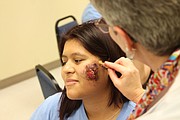CBTech students make fake injuries
MOSES LAKE — “I'm going to create a boil on your face. A great big pimple.”
Laura Cromer, an instructor at Big Bend Community College, was beginning to press a lump of putty on Adamary Najar's left cheek into a volcano shape.
Najar sat motionless while Cromer worked on the lump, but it was clear that Najar didn't much like the idea of having even a simulated pimple on her face.
Blood, gore, giant gashes, even simulated bones poking out of wounds — all of that was OK. But not a pimple.
Not even a fake one.
Cromer used a putty knife to cut a gash through the boil. After shaping it a bit, she squeezed a tube of fake blood into it.
“She didn't like the idea of a boil, so I lanced it,” Cromer said.
Najar was one of several dozen Columbia Basin Technical Skills Center students visiting the medical simulation program at Big Bend Community College to learn a little about moulage — the art of creating simulated wounds.
“The whole movement behind medical simulation is to make it look real and give a medical professional a real human to treat,” said Kristen McCrae, a nurse and educator at Good Samaritan Hospital in Moses Lake.
Paramedic Todd Schanze that it's important medical professionals learn to treat realistic looking wounds on actual human patients, because frequently they will find themselves dealing with people who are unconscious or cannot meaningfully describe their symptoms.
“This is part of the realism we bring to the training,” he said.
Besides, McCrae noted, at some point, medical professionals in training need to work on real human beings because they tend not to treat dummies with the urgency they would need to have when dealing with a real, injured human beings.
Simulated wounds used to be made of foam rubber and glued on as needed, Schanze said, pointing to a Tupperware container full of old, fake wounds. But today, students make their wounds themselves, using fake blood, chicken bones, and something called “schkin” — a kind of putty made from Vaseline, corn starch, and cocoa powder.
The CB Tech students enthusiastically go at the schkin, and the tubes of fake blood, with sponges and paint brushes and fingers, creating wounds and bruises and bloody gashes on arms, hands, and faces, creating an entire ward of trauma patients dealing with everything from protruding fractures to Najar's gross and bleeding boil.
Schanze, who spent some time training soldiers at Ft. Lewis, said he always tries to make sure the people he trains know they are dealing with fake wounds, as opposed to real ones, just in case some don't handle the trauma well.
“It's better to let them know,” he said.
Charles H. Featherstone can be reached via email at countygvt@columbiabasinherald.com.





